Saint Petersburg 2#
by Sergey Rumyantsev and Sergey Semenov,
members of the AirPano Team that is a member of the global-geography Consortium.
6 May 2011
with kind permission of AirPano
We had been preparing for the shooting in St. Petersburg about a year. As early as summer of 2009 I was told that the helicopter excursion tours over the city in St. Petersburg were realized. I easily found the telephone numbers in the Internet and called there one day later.
For a long time we had been testing the equipment, preparing documents, adjusting permits, making contacts with the helicopter operators and, finally, one of our fellows — Dmitry Moiseenko — left for St. Petersburg for a test shooting. Unfortunately, it was raining and he just flew from The Peter and Paul Fortress to Pulkovo Airport. To realize the second test shooting, another photographer — Sergey Semenov — set off. In the beginning it just was dull but later the rain began again. But that time Sergey reached to make several panoramas over a take-off strip.
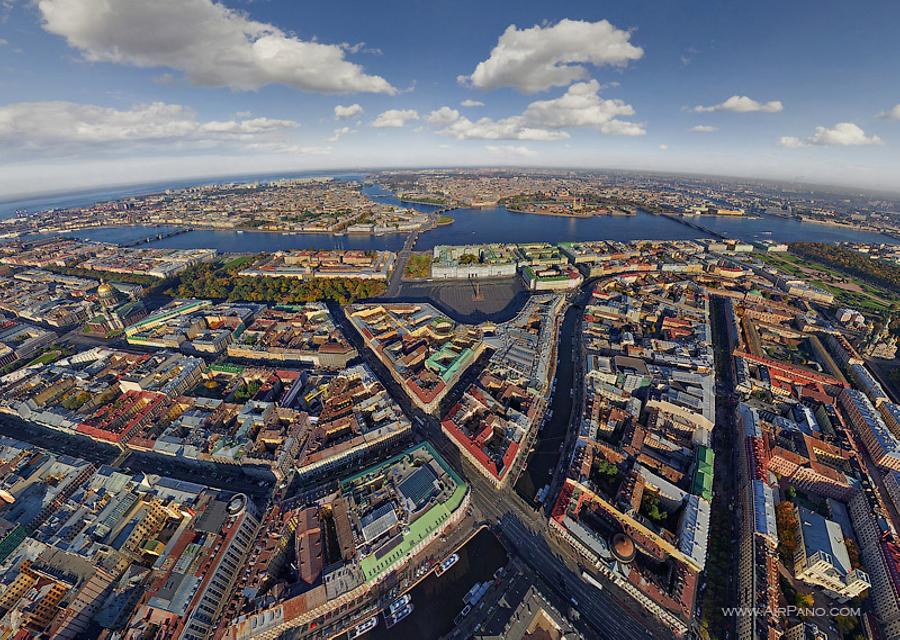
After that situation I understood that going that way we hardly would finish the shooting soon and decided to phone to a photographer whom I knew and who lived in St. Petersburg in order to find out what was the weather like there. "We are not lucky with sunny days", — I briskly said to the photographer by phone. "Shall we arrive in St. Petersburg and stay at a hotel and just wait when a sunny day comes?"
He answered gloomily: "I'm not sure this is the right way. In this case you may stay at the hotel a couple of months."
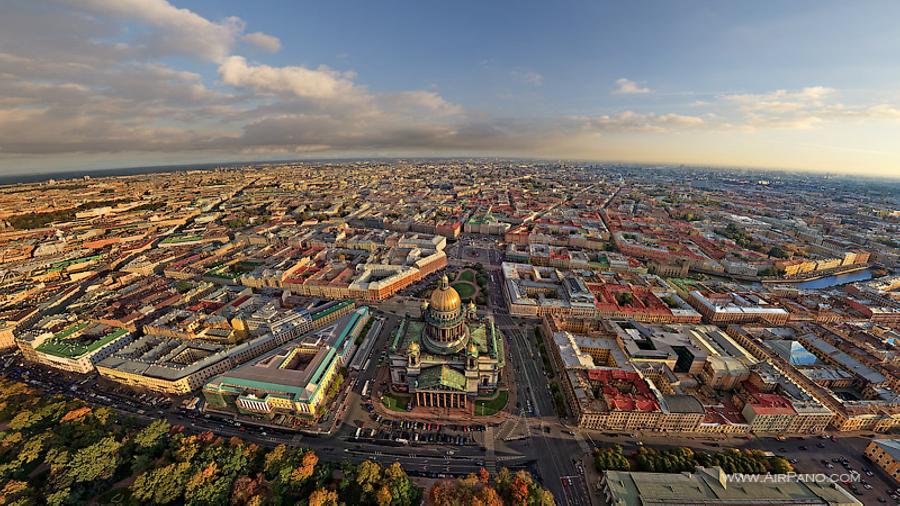
I was puzzled. We were not going to stay at the hotel for the couple of months. Then, we decided to conquer St. Petersburg by ruse.
We agreed with the helicopter operators as well as with a couple of our friends and the people whom we knew and who lived in St. Petersburg on as soon as the weather became better there, they would phone us in Moscow and we would take fast all we needed and would immediately leave. Nearly a week later in the morning the first phone call was received. "There is the sun outside our window and, if you hurry up and arrive before lunch time, you can shoot because the rain is forecasted in the afternoon."
But it was impossible because we needed a half of day just to get to St. Petersburg and another half of day to arrange the flight and shooting. We needed the whole day, the whole sunny day. And this is too much for ST. Petersburg! We had been packed and ready to go but we had to wait. The friends made a couple of calls but every time could offer only a half of day and that wasn't satisfied us.
One day, a month later, we were phoned by everyone all together: by friends, people whom we knew and even helicopter operators. "Today is still dripping from the sky but tomorrow... tomorrow you will be happy! Harry up!"

And we got off with a jerk. We had nearly missed our plane. Having come rushing into the check-in area of Vnukovo Airport 35 minutes before the take-off, we knew that there was no way to get tickets for the last plane to St. Petersburg. However, it took us five minutes of negotiations directly with the representative of the UTair Company (we are very grateful to him for that) to get boarding passes with no sits. But our troubles hadn't finished then. We had got two two-meter bars and a bag with different metal things weighted about twenty kilos. And it was important for us to take all those goods in a hand luggage. Widely opened eyes of the security men who were checking the hand luggage didn't show us anything good. And only the personal charm of Sergey Semenov let us not only to pass through the metal detector but also to convince the stewardesses to hide our equipment in their service cabinet on board.
As a result, in the evening we happily and safely arrived in St. Petersburg, slept a night and took a helicopter in the morning. The weather was amazing and it seemed to us that it would always be the same.
We successfully shot and landed near the Peter and Paul Fortress. Our colleagues-photographers were coming there too. They were going to shoot from a huge dirigible named Megaphone. They began to unpack the equipment and prepare the dirigible for the flight. They had been waiting for a good weather more than a month too and that moment they were preparing for the shooting and hoped to compensate the time lost. There were the operators from the First Russian TV-Channel and some other people from television.
By the afternoon we had decided to fly once again because very beautiful small clouds appeared in the sky and the helicopter stood right near us. We flew up again, shot about half an hour and came back to the Peter and Paul Fortress. And there was something unusual in the sky! From the side of the Gulf of Finland a huge cloud was coming closer and closer. It had already covered a half of the city when the second part was shown by the bright sun. The city was divided into two parts like with a front line. The wind rose.
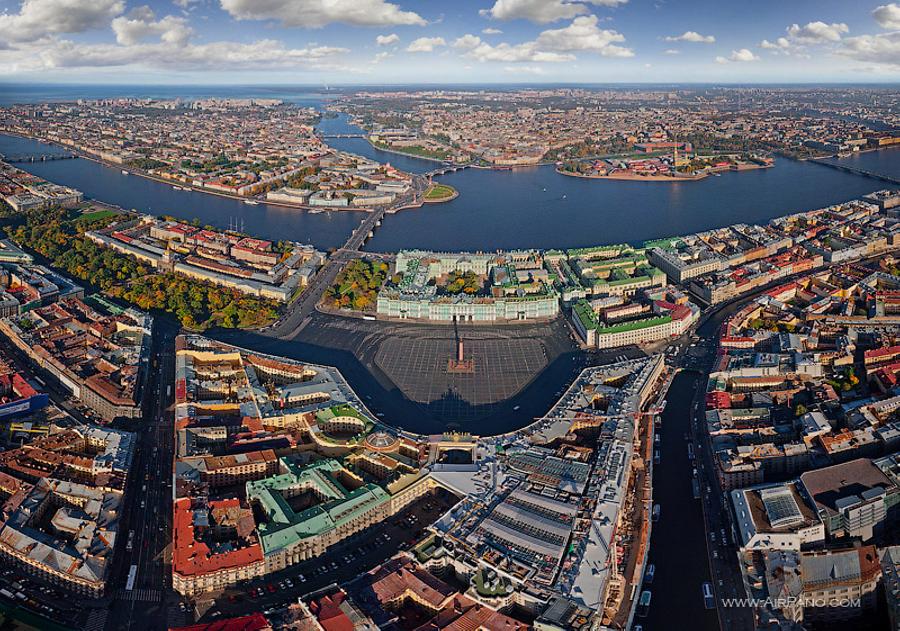
We were landing when the people with the dirigible were finishing their preparations for the flight, but we definitely knew that they wouldn't be able to fly up that day.
That evening we left St. Petersburg accompanying with the sounds of thunder. The big rain drops were pattering on the train's windows but we were not upset anymore — our work had been done. A year of preparation, a month and a half of waiting for a good weather and an hour and a half of the flight over one of the most beautiful cities in Russia — all those were in past. That was the way how we realized our virtual tour shooting over St. Petersburg.
And now allow us to share few interesting facts about St. Petersburg:
St. Petersburg is a city built on orders. Once having chosen the most convenient place where from it would be easy to threaten the Swedes, Peter I ordered and the construction started. In the history there aren't so many cities which were built in short terms at sovereign's command, but those are even less which could save their architectural aspect through ages.
St. Petersburg was lucky: its buildings had been created before 1917, has almost completely been saved and now they are about 18 thousand. Due to that fact the center of the city represents a harmonic architectural ensemble as well as it has another very special detail which is a scope and plenty of water (10% from the total area!) that make St. Petersburg unlike other cities of the world.
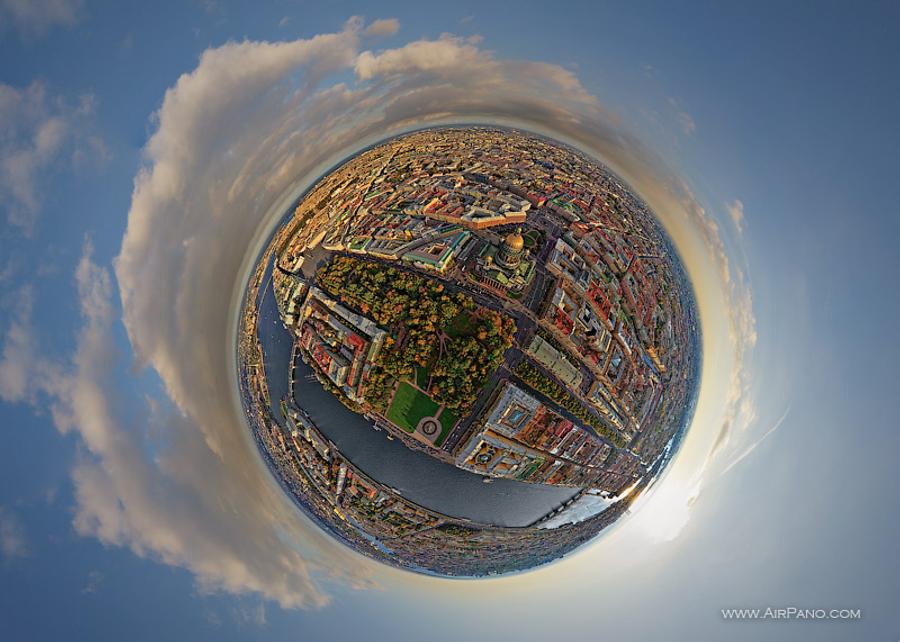
Another zest isn't so good - it is a legendary constant bad weather. The reason is still the same - water with its numerous local rivers both natural and artificial as well as bogs and lakes. The main arctic front also plays its role giving rise to the cyclones: a warm air mass of the middle latitude collides with a cold air mass of the high latitudes. These cyclones often affect St. Petersburg bringing floods, strong winds and gloomy clouds when it rains cats and dogs.
Our team of photographers was waiting for a sunny day in St. Petersburg so long that we could write a story about this. But, it seems to me, that it's better to say a few words about this beautiful city.
All panoramas were shot over the Neva's area of water. There are the most outstanding monuments of St. Petersburg. One of the first city's buildings is the Peter and Paul Fortress. Its foundations were laid on May 16 (27), 1703. More probably, the Swedes were so frightened by the fact of the construction that the fortress didn't serve as a defensive bastion. The Peter and Paul Fortress has never been used with its direct purpose but many years it was a sign building for "whenever an opportunity presents itself" and after the revolution it functioned as a jail for political prisoners.
In 1925 Leningrad Council resolved to destroy the fortress and to build a stadium instead. Fortunately, this resolution was cancelled. Now on the territory of the fortress there are a lot of museums, cafes, concert grounds including the Mint.

Besides, the highest Russian cathedral is that of Peter and Paul. The height of its belfry with a golden spire ended with the figure of a flying angel is 122.5 meters. Also there is a burial vault of the Romanov's royal dynasty. And daily at midday a signal gun shoots there. Its sound is so loud that it's better to be away from the fortress's walls at that moment. It is perfectly heard all around the center of the city.
The Trinity Bridge (to the left from the Peter and Paul Fortress) is the most beautiful bridges of St. Petersburg. There is a legend that in the middle of the 20's the soviet test pilot Valery Chkalov realized his famous flight by Hydro-plane Sh-2 exactly under this bridge. He was inspired to do that by his French colleague who could fly under the Eifel Tower for the considerable sum of money. But in Soviet Russia the only prize for Chkalov wbecame a guardroom and hooligan's fame.
The Spit of Vasilievsky Island has been a cultural and business center of the city still from the age of Peter I. In the 1720's the foundation of the Kunstcamera (it was the first Russian museum) was laid there. Then the port, bourse, customs and warehouses were moved there. The palaces and educational institutions were also built there. In 1810 the Spit was decorated by two Rostral Columns. One of them served as a lighthouse for the vessels on the Malaya Neva, another one showed the way to the Bolshaya Neva. It was necessary to move the river by 100 meters for them. Now they are monuments of Russian Navy Glory and used only during the festivals: these days their lights are on.
Telling about the lights, the first Russian experience of a street electric lightning was held particularly in St. Petersburg: in 1879 the Liteyny Bridge was lightened.
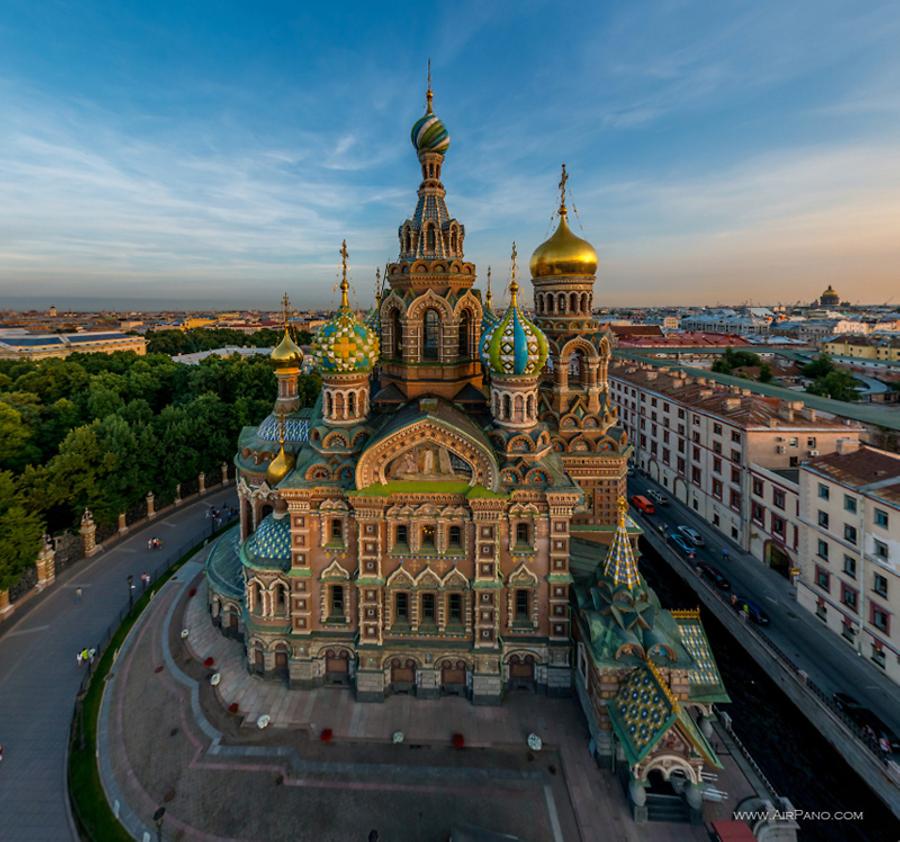
In the Winter Palace palace, where the tsars killed time of St. Petersburg endless winters, now there is the biggest world museum, the Hermitage, situated. In its collection there are about 3 million museum pieces. It would take someone 8 years to revise the museum pieces if to look at one museum piece at least one minute. Besides, to look through all the museum pieces it would need to walk the distance of 20 kilometers.
Palace Square is decorated with the Alexander Column. It is a unique monument of 47.5 meters height and its weight is about 700 tons. It is the highest monument in the world made of the whole granite. The column isn't fixed with anything and stands on the pedestal only under its weight. It is said that inhabitants of the city were afraid of walking nearby because they were frightened that the column would fall. The monument's author, Auguste de Montferrand, had to walk near the column daily to ensure its safety.
To the right from the Hermitage, along the riverfront, there is a splendid complex of buildings of the Russian Admiralty. The height of its spire is 72 meters. A ship-weathercock on the spire's pick weights 65 kilograms and it's covered with 2 kilograms of gold. Probably, these two kilograms of the precious metal so much worry the inhabitants of St. Petersburg that they make up another legend of the city. It seems to them that inside the gilt ball on the Admiralty's spire there is a hidden golden moneybox where the samples of all the golden coins issued from the day of St. Petersburg foundation are kept. Also, in the prow of the ship-weathercock the personal casket of Peter I can be found.
The casket in the ball really exists. However, there is no gold but the message about the works of spire and ship renovation for all the time that the building stands, as well as about the people who made such works. At the same time, the moneybox is still not found.
By the way, many people suggest for mistake that Saint Petersburg is named in the honor of its founder who was Peter I. But it isn't so: the city is named in the honor of the first Russian imperator's heaven protector - apostle Peter. But does it matter much? We invite you to admire the sights of the wonderful city from the bird's eye view.
26 Panoramas of Saint_Petersburg_1
12 Panoramas of Saint_Petersburg_2